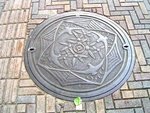
Frangipani has a gallery of some beautiful manhole covers in Japan. Some of them are very colourful.
Updated 2015: links broken, but google them :)

Frangipani has a gallery of some beautiful manhole covers in Japan. Some of them are very colourful.
Updated 2015: links broken, but google them :)
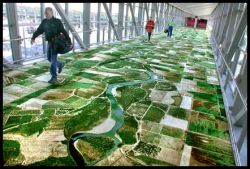 I do love public and community artwork! A few days ago the Wooster Collective pointed to the public art of Seyed Alavi. There are lots of great projects to browse through, but the Flying Carpet, an aerial view of a 50 mile stretch of the Sacramento River translated into woven carpet, which was made for a pedestrian bridge at Sacramento International Airport, is extra cool.
I do love public and community artwork! A few days ago the Wooster Collective pointed to the public art of Seyed Alavi. There are lots of great projects to browse through, but the Flying Carpet, an aerial view of a 50 mile stretch of the Sacramento River translated into woven carpet, which was made for a pedestrian bridge at Sacramento International Airport, is extra cool.
I also like What do you think? and Solitude.
David D. Schwartz has an interest in casino landscapes, and has a fine gallery of casino carpets (updated link to Wired article 2015). The Treasure Bay carpets make me smile thinking what might have been done with the old Pemberley site map.
I’m meandering now, but you also ought to check out the miraculous Peace Rug. Don’t miss the picture page. Lets ship one to our world leaders! (update: links no longer exist)
You might have seen pictures in the news of the Prime Minister and his wife dwarfed by a giant platypus, on the occasion of the opening of the Australian Pavilion at the World Expo in Aichi, Japan a couple of weeks ago. It was made by a team assembled by the Melbourne production company, think!OTS, and there are some images of the platypus there, if you check their portfolios.
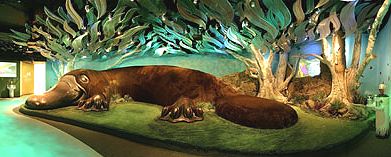
Yesterday I was delighted to also find photos of the making of the platypus exhibit at Australia at Aichi World Expo 2005 in their Pavilion Photo Gallery. Starting with an artist’s impression, they move on to show how the over-all shape was constructed out of foam, filled with plaster, coated with concrete and covered with leather and soft fur. It’s not clear to me from that description how they end up with hollow sections, but I’m guessing that its the concrete layer that forms the shell. The platypus measures about 11 metres.Here are a few other picture links:
‘Our Mary’ and Prince Frederick with the platypus
‘Our Mary’ sits on its tail
Mr and Mrs Howard with the platypus: 1,2 (both photos by Penny Bradfield)
Update: Platy-cam! (not available anymore)
 Meggiecat is a constant source of interesting art-craft-image-related notes. Her link to Japanese Free Clip Art the other day provided this lovely swallowtail butterfly image, for instance.
Meggiecat is a constant source of interesting art-craft-image-related notes. Her link to Japanese Free Clip Art the other day provided this lovely swallowtail butterfly image, for instance.
The designs reminded me of a book called ‘Snow, Wave, Pine:Traditional patterns in Japanese Design’ by Motoji Niwa and Sadao Hibi, which I sometimes page through in the bookshop. Its a beautiful collection of photographs of classic decorative patterns on a wide variety of objects (for example robes, laquerware, swords and ceramics), and many drawings of family crests and stylized motifs.
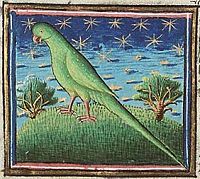 This green parrot is one of the many lovely animal illustrations catalogued on The Medieval Bestiary: Animals in the Middle Ages. Its a nicely organized site, with alphabetical ordering and cross-referencing, and information about the beasts from manuscripts. For each beast there is usually a gallery of different images from different sources.
This green parrot is one of the many lovely animal illustrations catalogued on The Medieval Bestiary: Animals in the Middle Ages. Its a nicely organized site, with alphabetical ordering and cross-referencing, and information about the beasts from manuscripts. For each beast there is usually a gallery of different images from different sources.
Did you know, for example, that a dragon’s strength is found in its tail, not in its teeth? And that ‘it is the enemy of the elephant, and hides near paths where elephants walk so that it can catch them with its tail and kill them by suffocation’? Or that ‘it is because of the threat of the dragon that elephants give birth in the water’?
 Canberra has been convulsed over the naughtiness of one of the local government’s staffers who was caught doing a spot of anti-Howard stencil graffiti. You have to hand it to local politics for making mountains out of mole hills!
Canberra has been convulsed over the naughtiness of one of the local government’s staffers who was caught doing a spot of anti-Howard stencil graffiti. You have to hand it to local politics for making mountains out of mole hills!
If you are interested in street art, take a look at The Wooster Collective: A Celebration of Street Art. They have some very cool images. For example, here is a Salvador Dali mural in Lima, Peru. They had an exclusive report on Banksy‘s activities in mid March, showing the works that he installed in four of the prestigious museums in New York.
There is also Wooster Mobile, ‘a Wooster curated art gallery of images which you can download onto your mobile phones in cities around the world’. The aim is to provide artists with a new revenue stream and at the same time generate funds for a non-profit organization called Keep A Child Alive, which provides life-saving drugs for AIDS sufferers in Africa.
This is a dawn picture of one of my favourite sculptures in Canberra, on Ellery Crescent outside the School of Art. Its by a Finnish artist, Olavi Lanu, and was made in 1982.

You can see it enlarged and from a few different angles here.
At first I really did think it was group of real granite boulders that just happened to look like a person sleeping. I like imagining that rocks or mountains are slumbering spirits that sometimes might stretch and come alive to go about their business when no-one is about. Of course there are lots of stories along those lines; the ancient stone creature in Patricia Wrightson’s children’s book The Nargun and the Stars comes to mind.
But Lanu’s reclining figure is made from fibreglass resin, presumably on a wire form. Apparently it was originally covered with moss, but over the years lichens have taken over. There is another figure by Lanu not far away, but sitting among some trees.
Finding Loobylu, and a very pleasant morning at Tilley’s last week, spent drinking coffee and sorting through a friend’s collection of fabrics, has made me dig out a picture of the quilt I made for my daughter about 8 years ago now. Its still loved and in use, but getting worn in places, particularly the blue-marbled silk that is in the wavy sea section of the middle panel.
I’m all enthused about Loobylu’s Month of Softies. The theme for February is ‘Alice in Wonderland’, and I’ve started making a white rabbit puppet!
This year I ordered a Georgia O’Keefe 2005 Calendar online, having been a slowcoach and letting January slip by without getting a new calendar for the year. It arrived last Friday, and it’s beautiful:
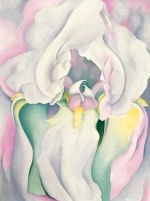
I do love her paintings, particularly her later more abstract landscapes.I used to like getting a UNICEF wall calendar each year, the kind that has drawings done by children from all over the world, but they were all gone. So was everything except dog or cat breed calendars, and even for half-price, and if I were obsessed with siamese cats, I don’t want to look at everyday siamese cat photographs all year. In fact I’ve never really understood why so many calendars have so little visual variety, except that I suspect they provide an easy avenue for Christmas shoppers, who can think ‘Oh, Auntie Mary loves cats, this will do for her’.Calendars that feature artistic interpretations of a single topic stand a better chance of being interesting, as long as you particularly like the style in which they are done, or there is some variation of style in the 12 illustrations. For example, in 2003 I had a calendar I loved, a cat calendar by Nicola Bayley. Its selection includes drawings from Bayley’s books The Necessary Cat: A Celebration of Cats in Picture and Word, Fun with Mrs Thumb, Katje, the Windmill Cat, and The Mousehole Cat, and although there are cats in all of them, and they all show Bayley’s exquisite attention to detail and the decorative, they tell so many different stories.
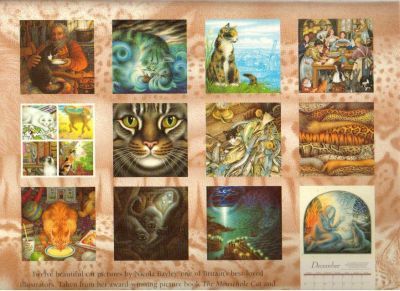
Nicola Bayley’s drawings have been a favourite of mine since my children were small; we had two of her books: The Mouldy, and The Patchwork Cat (written by William Mayne). When I was the illustrator for the Republic of Pemberley in the 90’s, the cat drawing that I did for the Portrait of our Community board was inspired by those in The Patchwork Cat.